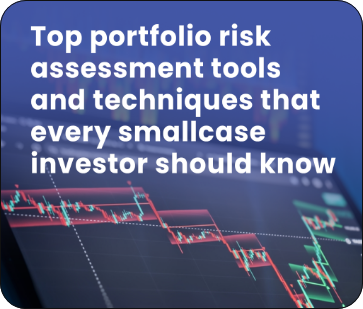
How monsoon affects the Indian stock market:
what investors should do?
If you're an Indian investor, there's one weather forecast you can’t afford to ignore — the monsoon.
Sure, global oil prices and US Fed announcements move markets. But between June and September, those towering rain clouds carry more than just water, they carry market sentiment.
Why? Because the Indian economy doesn’t just grow, it grows when it rains.
But the monsoon’s influence on markets isn’t linear. Some years, a great monsoon barely nudges the index. Other years, a few missed rain days send entire sectors reeling. What gives?
In this article, we explore how these rains shape the economy, swing sector sentiment, and, most importantly, how you, the investor, can ride the volatility instead of drowning in it.
Table Of Contents:
Why Does Monsoon Matter for the Indian Economy?
“Isn’t India less dependent on rain now?” That’s a good question. And the short answer is: not really!
Yes, India’s economy has diversified. Yes, urban services and tech have boomed. But agriculture still employs nearly half the population, and a full 50% of cropped land is rain-fed.
So when monsoon hits (or misses), here’s what actually gets affected:
- Food output, which hits
- Rural income, which impacts
- Consumer demand, which moves
- Corporate earnings, which move
- Stock prices, which bring us here.
In other words, rainfall drives consumption, and consumption drives India’s GDP.
The Math Behind the Monsoon
A normal monsoon brings in about 7,000 trillion litres of rainfall, covering 70% of the country’s annual water needs.
In a good year, farm output goes up, rural demand spikes, FMCG shelves empty out, two-wheelers roll faster off showrooms, and tractor sales break charts.
In a bad year, crops fail, food inflation spikes, the RBI raises interest rates, and consumption takes a nosedive.
Sectoral Impact of Monsoon: Who Wins, Who Loses
Who Wins?
- FMCG with rural exposure: Think Nestlé, Britannia, HUL. When the harvest is strong, villages stock up on biscuits, soap, and shampoo. Companies clock record volumes. Everyone’s smiling.
- Auto: Mahindra & Mahindra, Hero MotoCorp, and Bajaj Auto all depend heavily on rural sales. A good monsoon means more farm income — more two-wheelers, more tractors, and more torque on quarterly results.
- Agri-inputs: Fertilizer, seeds, and pesticide companies like Coromandel International and Dhanuka Agritech flourish when sowing is healthy.
Who Loses?
- Construction and cement: Rain halts projects, disrupts supply chains, and weakens demand. Cement stocks like UltraTech and ACC often underperform in heavy monsoon quarters.
- Logistics and transportation: Flooded roads, blocked rail routes, and delivery delays can dent revenues for logistics companies, especially those dealing in B2B transport.
- Consumer durables: No one’s buying a refrigerator when they’re wading through waterlogged roads. Sales of high-ticket items in rural markets fall when the rains don’t cooperate — or when they overstay their welcome.
So, how can investors optimize their probability of investing in profitable sectors?
Ideally, you can choose the best smallcase company like PINC Wealth and leverage their expert-curated portfolios with strategic investment practices.
How Monsoon and Market Correlate: Major Historical Trends
So does the stock market rise when it rains? Not exactly. The relationship is complicated, like your portfolio after March 2020!
According to Wright Research, monsoons don’t directly move the Nifty. But they create ripple effects across sectors, and those ripples can compound over quarters.
Let’s look at some significant years:
- 2009: It was a drought year. Agriculture growth was -0.2%. But Nifty delivered 75% returns, thanks to the post-GFC recovery. Lesson? Global liquidity > local rainfall.
- 2015: Rainfall 14% below normal. Food inflation rose, and rural demand dipped. FMCG and auto underperformed. This time, the market noticed.
- 2022: A strong monsoon year where rural demand rebounded. Stocks like M&M and Britannia rallied over 15% in Q3 alone.
Timing is everything!
Rainfall in June sets the mood. Rainfall in July and August decides the outcome. That’s when sowing happens. If it rains well during this window, kharif crops boom, consumption picks up, and earnings beat expectations.
If rainfall is delayed or concentrated in fewer days, it causes both floods and droughts, and markets start to sweat.
It becomes critical for investors to align their investment strategy to accommodate market volatility and trends during the monsoon.
To do that, you should aim for the best smallcase portfolios, such as PINC Momentum Fundamental, offering stocks where visibility in earnings continues for 4 to 6 quarters.
How Do Investors Navigate Through Monsoon Volatility?
When it comes to monsoon-driven volatility, the biggest mistake investors make is overreacting. Forecasts shift, rain patterns vary, and markets often move on sentiment more than actual impact.
The key is to stay grounded and not let short-term noise derail long-term strategy. Instead of tracking headlines, focus on real indicators—weekly rainfall deviation, reservoir levels, and sowing data. These tell a more accurate story than a single IMD press release.
Monitor Sector Cues
FMCG, auto, and agri-inputs tend to benefit in strong monsoon seasons. Construction and consumer durables often underperform during erratic rainfall.
Rotate Smartly
Adjust exposure based on how rural demand is shaping up, but don’t try to time every move.
Think in Quarters, Not Days
Monsoon effects unfold over time. Panic selling rarely works. Patience and perspective lead to better outcomes.
Balance Your Bets
Mix weather-sensitive stocks with sectors that are rain-proof, like technology or banking, to reduce portfolio whiplash and build more resilience.
Conclusion
India's economy is evolving, but the monsoon still holds the steering wheel more often than we admit.
It can cause inflation spikes, corporate downgrades, or surprise rallies. It can shift consumption, earnings, and even monetary policy.
As an investor, your job is not to fear the season, but to understand how it flows into valuations, sector dynamics, and sentiment.
We at PINC Wealth offer expert-curated, well-balanced, and highly researched smallcase investment portfolios that can help you weather volatility and tap into long-term opportunities. Start your investment journey with confidence today!
Related Articles

How will the US Fed rate cut impact inflation, Indian markets and your investment portfolio?
US Fed rate cuts influence Indian markets, currency trends, and smallcase stocks. Explore sectors that benefit, risks, and smart investment strategies for 2025.
Know more
What is WACR, and why does RBI retaining WACR matter for your portfolio?
Understand WACR and RBI's revised liquidity framework. Learn how these monetary policy changes impact your smallcase investment and portfolio returns.
Know more
‘Bite-sized’ smallcase investments: Low entry-cost portfolios for new and young investors
Making investment even easier and simpler with ‘bite-sized’ smallcase portfolios. Here’s a guide for beginners on how to start and build long-term wealth.
Know more
Top portfolio risk assessment tools and techniques that every smallcase investor should know
Learn about the top portfolio risk assessment tools and techniques that every smallcase investor should know to analyse and manage the potential risk, and how financial advisors help in this effectively.
Know moreMeet the people
we served!
PINC Compounder Smallcase has simplified my investment journey. Seriously, investing has never been easy for me! Here in a single click, I could access a balanced portfolio. Thanks PINC.
Mr. Akhilesh
I was hesitant about investing, but PINC Smallcase changed that. Talking to their team and looking at their growth gave me confidence. I've seen my investments grow steadily since then. I'm impressed!
Devendra Palan
As someone with limited knowledge about the stock market, I found Pinc smallcase to be a reliable and accessible platform. Their detailed reports and analysis have given me a deeper understanding of the stocks in my portfolio. I feel confident in managing my investments.
Pratik Gandhi

Subscribe to our email list
Sign up for Expert Insights
Your Gateway to Smarter Wealth
Management!